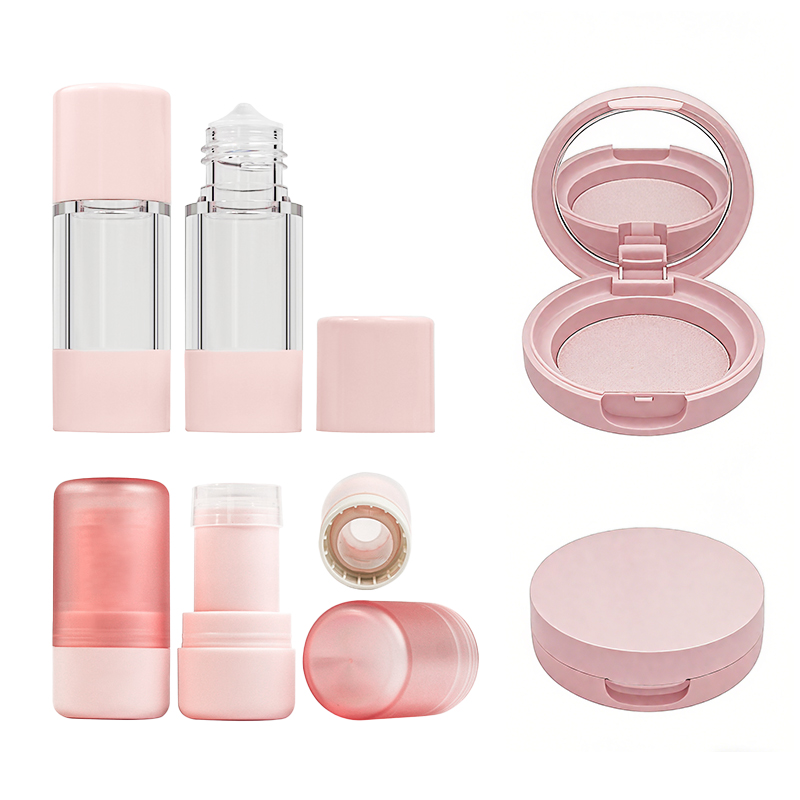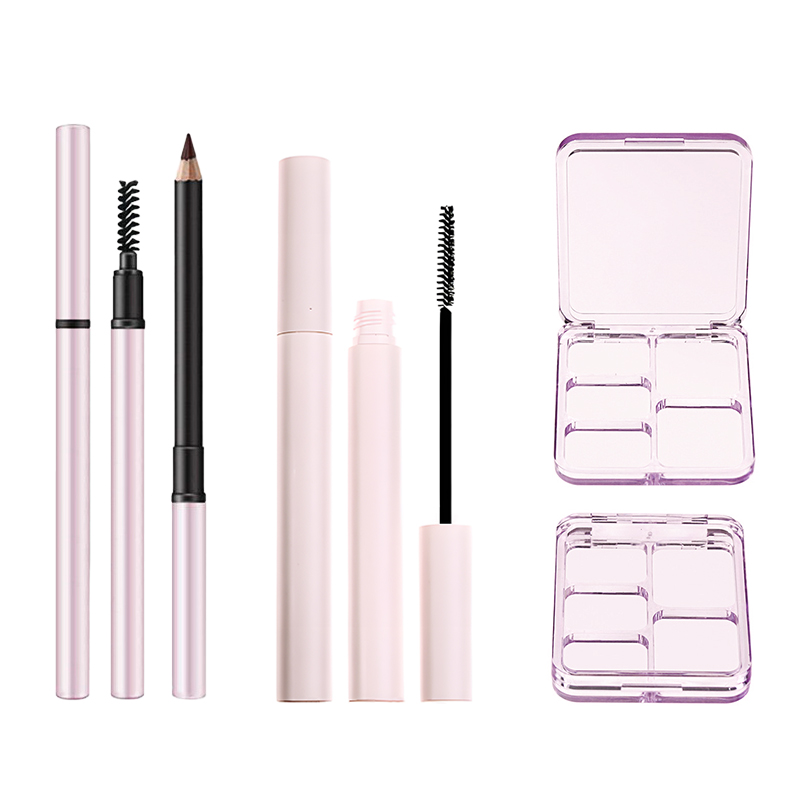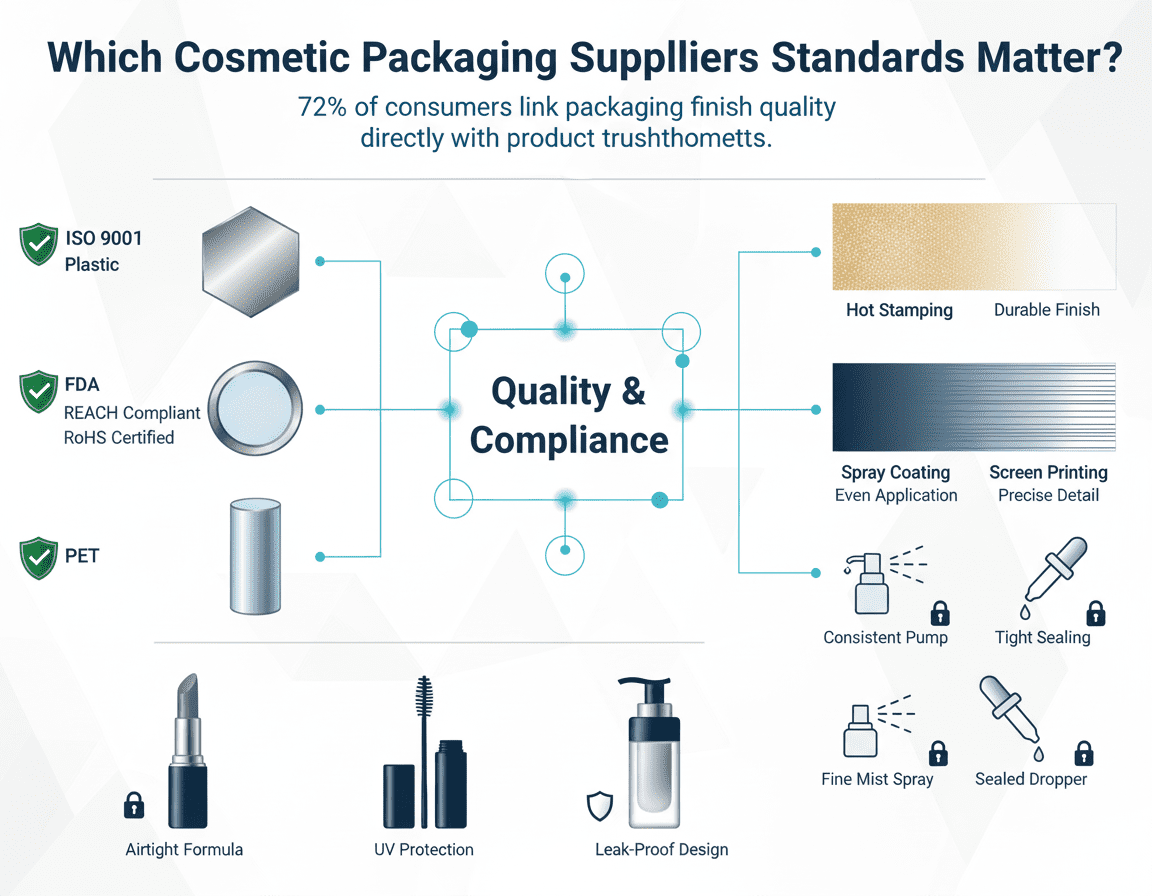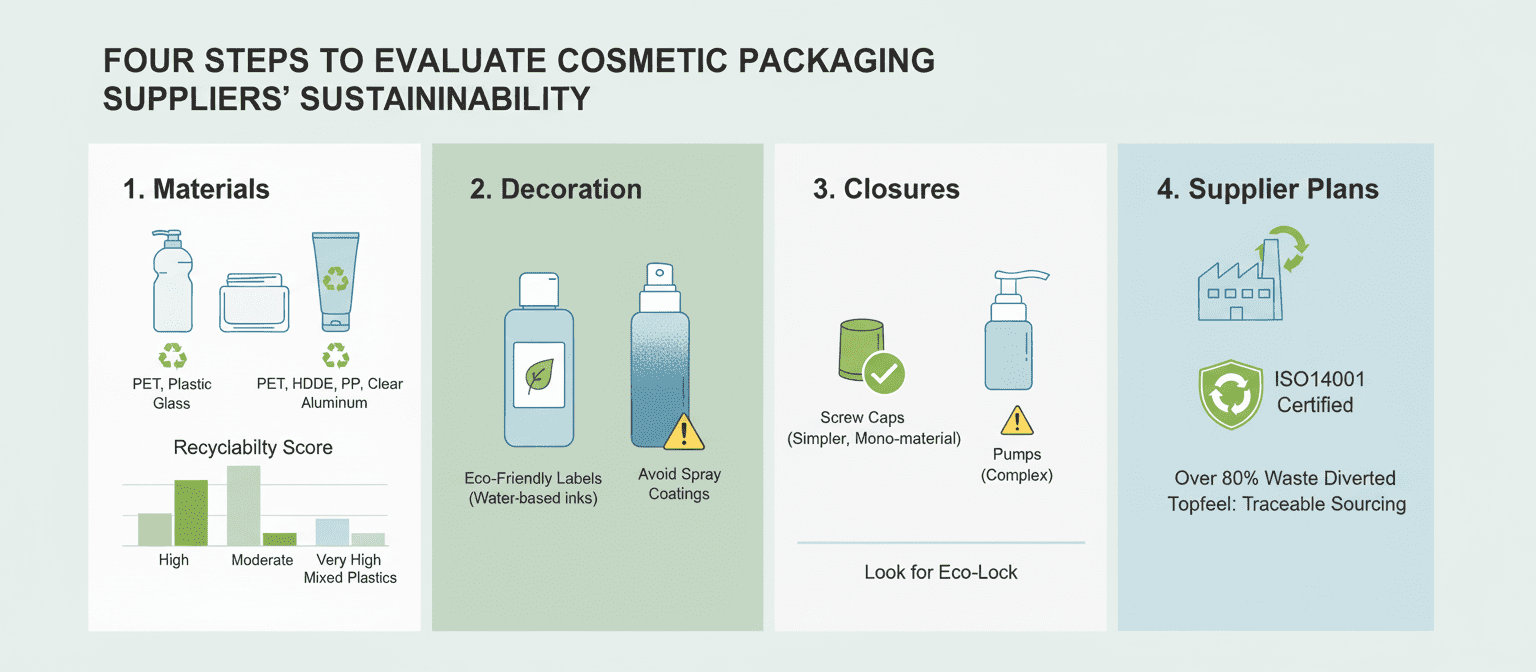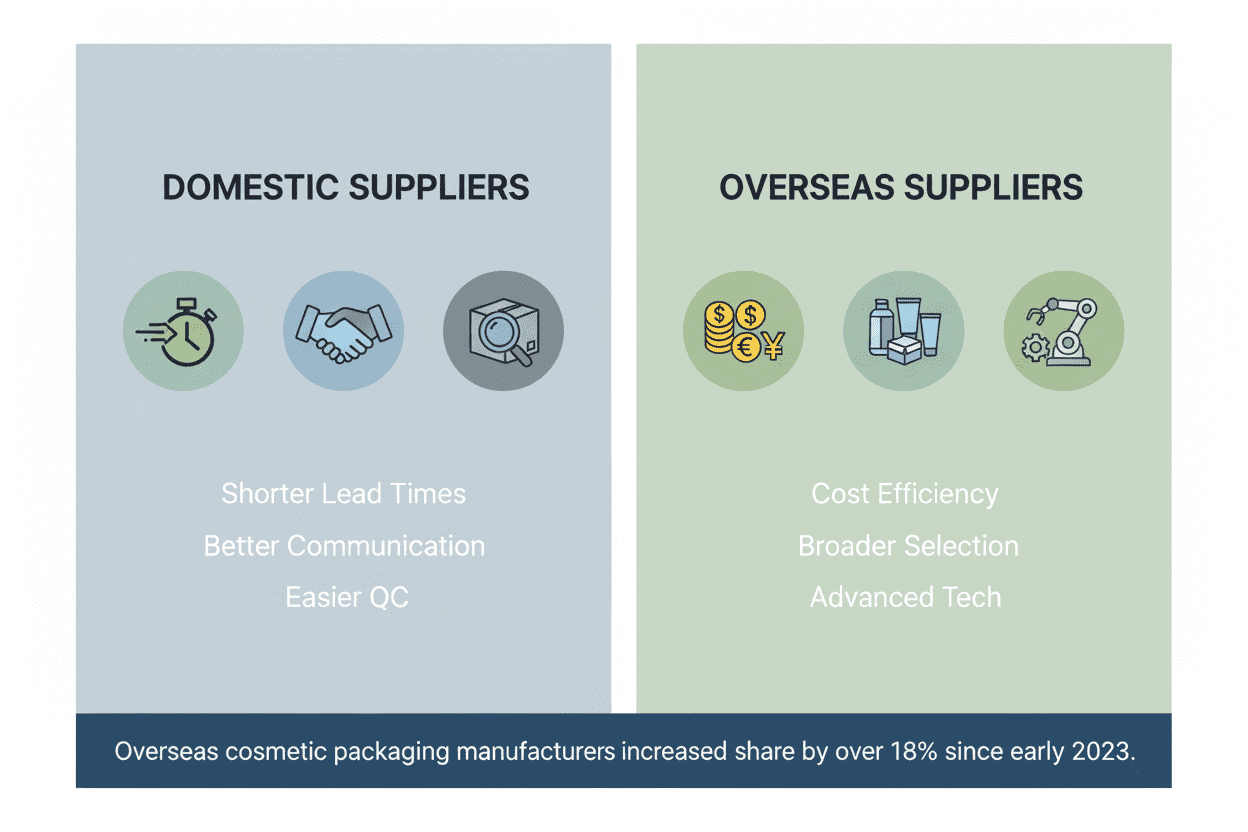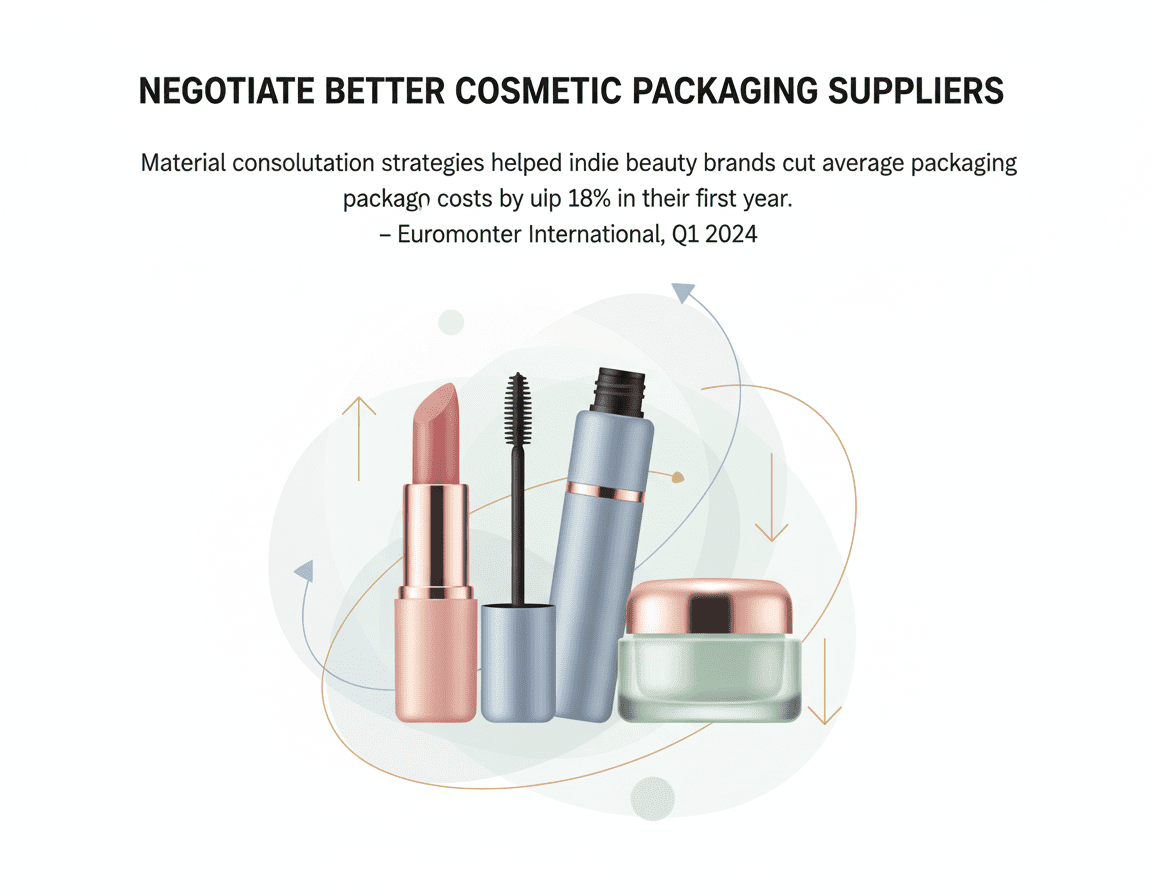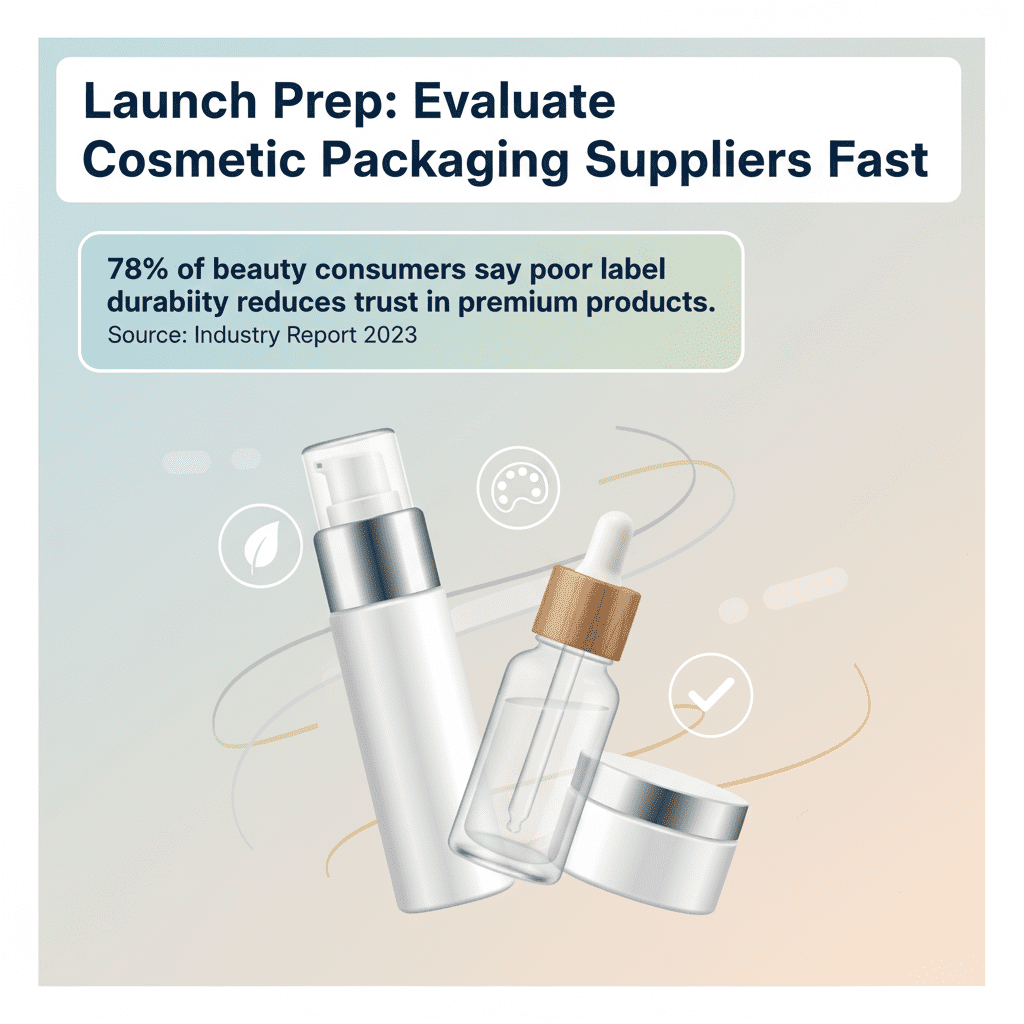Quick Tips for Choosing Cosmetic Packaging Suppliers
Launching a new product and picking cosmetic packaging suppliers feels a bit like speed dating with long-term consequences—except your date needs to deliver flawless pumps, eco-certifications, and hit your MOQ without ghosting you halfway through production. One wrong decision and boom: budget blown, deadlines missed, or worse…your serum leaks all over the shelf.
In 2023 alone, 58% of beauty brands reported supplier delays impacted their go-to-market timelines (McKinsey Beauty Report).
That’s not just lost time—it’s lost shelf space. And when you’re racing toward launch day with retail partners breathing down your neck? You can’t afford missteps from a flaky vendor who doesn’t pick up the phone after 5 PM.
So how do smart buyers cut through the noise and spot real-deal suppliers in a sea of shiny samples and empty promises? Buckle up—we’ve got sharp tips that’ll save your sanity and your margins.
Key Points in Choosing Cosmetic Packaging Suppliers Without Losing Sleep
➔ Material Certifications Matter: Prioritize suppliers who offer certified plastic, glass, or PET packaging to ensure safety and compliance with cosmetic regulations.
➔ Decoration Defines Shelf Appeal: Evaluate hot stamping, spray coating, and screen printing for durability and brand aesthetic—cheap finishes could cost you customer trust.
➔ Closures Can Make or Break You: Pumps, droppers, and spray nozzles must be tested early for leak resistance and ease-of-use—especially for liquid formulas like foundation or mascara.
➔ Sustainability Isn’t Optional: Look beyond recyclable materials; assess eco-friendly decoration methods and a supplier’s recycling policies to meet consumer expectations.
➔ MOQ Tricks That Work: Bundle orders across lipstick, eyeliner & mascara formats—or negotiate shared decorations—to bring down minimums without bloating your inventory.
➔ Domestic vs Overseas Trade-Offs: Domestic suppliers offer speed and clear communication; overseas may provide cost savings—but only if timelines aren’t mission-critical.
Which Cosmetic Packaging Suppliers Standards Matter?
Choosing the right cosmetic packaging partner isn’t just about aesthetics—it’s about safety, performance, and meeting global standards that matter.
Plastic, Glass & PET Material Certifications
The materials used—be it PET, glass, or plastic—must meet strict certifications to ensure they’re safe for cosmetics. Here’s what to keep an eye on:
- ISO 8317: Child-resistant packaging standard.
- FDA CFR Title 21: Ensures material compatibility with cosmetic ingredients.
- REACH Compliance: European regulation for chemical safety.
- RoHS Directive: Limits hazardous substances in plastics and coatings.
- Biodegradability ratings are essential if you’re chasing a greener footprint.
A smart move? Ask your supplier directly for their test reports. No reports? That’s a red flag waving high.
Decoration Quality: Hot Stamping, Spray Coating, Screen Printing
Decorations aren’t just pretty—they speak volumes about your brand’s quality standards. Think beyond the shine:
• Hot stamping should resist scratches and fading over time.
• Spray coating must be evenly applied without bubbles or discoloration.
• Screen printing needs to stay crisp even after months on a shelf.
Each technique has its quirks. For example, hot stamping may look luxe but can crack on curved surfaces if poorly applied. Always check durability tests before signing off.
According to Euromonitor International’s Q1 2024 report, over 72% of consumers link packaging finish quality directly with product trustworthiness—a stat worth remembering when choosing decoration methods.
Closure Performance for Pump, Spray Nozzle & Dropper
You don’t want leaky pumps or misfiring nozzles messing up the user experience. Here’s how good suppliers prove their closures deliver:
Grouped by Functionality:
Pumps
-
Must pass vacuum retention tests.
-
Should dispense consistent volume per stroke.
-
Spring mechanisms need fatigue testing over repeated use.
Spray Nozzles
-
Atomization should be fine and uniform.
-
Anti-clog valves are a must for oil-based formulas.
Droppers
-
Require controlled flow rate and tight sealing caps.
-
Silicone tips should resist deformation under pressure.
If these elements fail even once during transit or usage? That could mean product returns—and worse—brand damage you can’t afford.
Product Compliance in Lipstick, Mascara & Foundation Packaging
Every type of cosmetic formula comes with its own packaging demands—and failing to meet them can lead to serious compliance issues.
Short Snapshots:
Lipsticks need airtight barrels so waxes don’t sweat or melt unpredictably.
Mascara tubes must be made from non-reactive polymers that won’t alter the formula over time.
Foundation bottles demand UV-blocking materials if they contain light-sensitive actives like vitamin C or niacinamide.
And don’t forget compatibility testing—it’s not optional; it’s critical. Even the prettiest bottle is useless if it reacts with your pigment base or causes separation after filling.
One mention here: Topfeel was among the few manufacturers cited by SGS Global Labs this year for exceeding compliance benchmarks across all three categories above—a rare nod worth noting when vetting potential partners.
Four Steps To Evaluate Cosmetic Packaging Suppliers’ Sustainability
Want packaging that walks the green talk? Let’s break down four key ways to spot truly sustainable players in the beauty biz.
Step 1 – Evaluate Recyclable Plastics, Glass & Aluminum Use
- PET, HDPE, and PP plastics are recyclable champs. The more of these used, the better.
- Clear glass trumps colored versions when it comes to ease of recycling.
- Aluminum earns points for infinite recyclability and lightweight shipping perks.
| Material Type | Recyclability Score | Energy to Recycle | Common Use |
|---|---|---|---|
| PET Plastic | High | Low | Bottles |
| Glass | Moderate | High | Jars |
| Aluminum | Very High | Very Low | Tubes |
| Mixed Plastics | Low | Moderate | Caps |
When choosing cosmetic packaging, look beyond the pretty face—what it’s made from matters more than you think.
Step 2 – Assess Eco-Friendly Decoration: Labeling vs. Spray Coating
- Labels made from biodegradable or recycled paper are a win—easy to remove and don’t pollute recycling streams.
- Water-based inks reduce VOC emissions compared to traditional solvent-based options.
- Avoid spray coatings with heavy metals—they’re flashy but nasty for recyclers.
Spray-coated finishes may look glam on store shelves, but they often make containers unrecyclable junk. Stick with simple decor if you care about environmental impact.
Step 3 – Check Closure Lifecycle for Screw Cap & Pump
• Pumps often contain metal springs and multiple plastic types—harder to recycle unless disassembled properly.
• Screw caps are simpler and usually mono-material—easier on sorting systems at recycling facilities.
• Look out for closures labeled as “eco-lock” or “mono-material”—these simplify end-of-life handling big time.
A pump might feel luxe, but a smart screw cap could be your best bet if you want your product to align with real sustainability values.
Step 4 – Review Supplier Recycling & Waste Management Plans
Some suppliers claim they’re green—but what do their operations actually look like?
• Do they offer take-back programs or closed-loop recycling systems? That shows serious commitment.
• Are their manufacturing facilities ISO14001 certified? That’s a legit sign of environmental management standards being followed.
• What percentage of production waste is diverted from landfills? Anything over 80% is impressive.
Topfeel stands out by offering fully traceable sourcing and post-consumer resin integration across its packaging lines—a rare combo among today’s cosmetic packaging suppliers.
If your supplier can’t answer these questions confidently, it’s time to find one that can walk the eco-walk—not just talk it.
Domestic Vs. Overseas Packaging Suppliers
Choosing between local and international packaging partners? Here’s what you need to weigh before sealing the deal.
Domestic Suppliers
Local vendors can be a smart move when speed, trust, and hands-on control matter most.
- Shorter lead times: Working with nearby suppliers slashes transit delays. That’s a game changer when production timelines are tight.
- Better face-to-face communication: You can hop on a call—or even visit the facility—to hash things out quickly. No timezone gymnastics required.
- Easier quality control: It’s simpler to monitor standards when you’re just a drive away. If something goes sideways, fixes happen faster.
Grouped benefits:
- Faster shipping = fewer stockouts
- Real-time feedback loops with your supplier team
- Lower risk of IP theft thanks to stronger domestic legal frameworks
While pricing might be slightly higher than offshore options, many brands find that the trade-off is worth it for peace of mind and predictability.
Overseas Suppliers
Going global can open doors—especially if you’re chasing lower costs or cutting-edge materials.
- Cost efficiency: Many overseas manufacturers offer significantly cheaper rates due to lower labor and production expenses.
- Broader selection: You’ll often find more variety in materials, finishes, and customization options abroad—especially from regions like Southeast Asia or Eastern Europe.
- Access to advanced tech: Some international factories are ahead of the curve with automation and eco-friendly processes.
Grouped considerations:
- Watch out for longer lead times, especially during peak seasons or customs slowdowns
- Language barriers may complicate communication unless your partner has strong English-speaking reps
- Keep an eye on tariffs—they can eat into savings fast
A recent report from Smithers Pira noted that “overseas cosmetic packaging manufacturers have increased their share by over 18% since early 2023,” mainly due to innovation-driven demand shifts. Still, balancing cost savings with potential risks is key—especially when dealing with fragile supply chains or strict brand standards.
Whether you’re sourcing jars for skincare or pumps for serums, choosing between domestic or international suppliers comes down to what matters most for your business: speed, cost, control—or all three.
Struggling With MOQ? Negotiate Better Cosmetic Packaging Suppliers
Getting stuck with high MOQ demands from your cosmetic packaging suppliers? Here’s how you can cut smarter deals and keep your production lean without sacrificing quality.
Bundling Lipstick, Mascara & Eyeliner Orders to Reduce MOQ
- Group different SKUs like lipsticks, mascaras, and eyeliners under one packaging order to meet the supplier’s minimum volume.
- Use similar bottle or tube formats across products to simplify procurement and reduce mold costs.
- Ask your supplier if they allow mixed product bundling—many smaller manufacturers are open to it if it keeps machines running.
- Keep component dimensions consistent where possible; shared caps or inserts can lower unit pricing when ordered in bulk.
- Consider using a unified color palette across these items—this often qualifies as a single decoration run.
- Align launch timelines so that you’re ordering multiple items in one go rather than spacing them out and missing volume discounts.
- Some boutique suppliers offer “family pack” MOQs where you hit the total with varied SKUs instead of just one item.
Negotiating Tube, Bottle & Jar Quantities with Suppliers
Start by knowing what part of the package drives up cost—is it the mold setup? The decoration process? Or raw material pricing?
• If you’re sourcing tubes for skincare but only need half the standard MOQ, ask about off-the-shelf options that don’t require custom molds.
• For jars or bottles made from glass or acrylic, request split shipments—some vendors will hold inventory for future delivery at no extra charge.
• Combine orders across seasonal launches; ordering ahead helps suppliers plan production more efficiently and may earn you better terms.
→ Sometimes it’s less about quantity and more about timing. A well-timed reorder promise can help lower initial minimum order quantity demands.
→ Be transparent about your growth projections—it builds trust and gives room for flexible contract terms down the line.
→ Don’t hesitate to pit multiple packaging suppliers against each other in bidding rounds; competition often leads to better deals.
Securing Discounts for PET, Acrylic & Glass Packaging
PET is cheap but not always sexy; acrylic looks premium but costs more; glass screams luxury yet breaks hearts—and budgets—if mishandled.
Short-run orders usually carry a price penalty—but there are ways around that:
• Choose clear PET when possible—it’s widely stocked and easy for vendors to fulfill quickly at scale.
• Acrylic discounts often kick in at 10K+ units per SKU, but some factories now offer tiered rates starting as low as 3K units if ordered quarterly.
• For glass packaging, try working through domestic distributors who consolidate small-batch imports—you’ll pay slightly more per unit but avoid full-container commitments.
According to Q1 2024 data from Euromonitor International: “Material consolidation strategies helped indie beauty brands cut average packaging costs by up to 18% in their first year.”
So yeah—being strategic with materials matters just as much as negotiating price tags.
Decoration Leverage: Screen Printing vs. Labeling for MOQ Deals
- Screen printing requires setup fees but offers durability—ideal if you’re committing long-term.
- Labels are cheaper upfront and work great for test runs or seasonal collections with fast turnarounds.
- Ask about hybrid options like hot-stamping over labels—it might qualify you for mid-tier MOQs while still looking luxe.
- Vendors sometimes waive decoration MOQs entirely if you’re bundling multiple SKUs under one design format.
- If you’re locked into high decoration volumes just because of branding quirks—consider simplifying artwork temporarily during scale-up phases.
When it comes down to negotiating with your cosmetic packaging partners, remember this: flexibility isn’t given—it’s earned through smart planning and honest conversations backed by real business potential.
Launch Prep: Evaluate Cosmetic Packaging Suppliers Fast
Before your product hits shelves, you’ve got to size up those packaging partners—quickly and smartly. Here’s how to do it without breaking a sweat.
Speedy Material Check: Plastic, Glass & PET Certification
Getting the lowdown on materials shouldn’t feel like pulling teeth. Here’s what you can check fast:
- Plastic type: Is it BPA-free? Does it meet FDA or EU standards?
- Glass grade: Look for Type I borosilicate if you’re dealing with sensitive formulas.
- PET clarity: Food-grade PET offers both safety and shelf appeal.
💡 Bonus tip: Ask suppliers to provide digital copies of their compliance certificates upfront—don’t wait until after sampling.
These quick checks help you dodge quality mishaps while keeping your launch preparation timeline tight.
Rapid Decoration Sampling with Hot Stamping or Screen Printing
Branding is make-or-break. You don’t have time for reprints that look off-color or smudged. Here’s how you can speed-test decoration services:
• Request small-batch samples using your actual artwork and logo colors.
• Compare hot stamping vs screen printing side-by-side under natural light conditions.
• Test adhesion by rubbing the print lightly with alcohol swabs—if it fades, it’s a no-go.
According to Mintel’s April 2024 packaging trends report, “78% of beauty consumers say poor label durability reduces trust in premium products.” Don’t let sloppy decoration kill your vibe—or your sales.
Quick Closure Testing for Pump, Spray Nozzle & Dropper
Closures might be tiny, but they pack serious punch when it comes to user experience—and they better work right outta the gate.
🟢 Pumps should dispense evenly without clogging after multiple uses.
🟢 Sprayers must deliver fine mists without sputtering or leaking down the neck.
🟢 Droppers need consistent suction power and zero drips during application tests.
Run these tests on at least three units per closure type before giving any supplier the green light. A clunky pump can tank even the fanciest serum launch—no joke.
Why Fast Vetting Matters More Than Ever
Speed isn’t just about being first—it’s about staying relevant while maintaining solid quality and avoiding wasteful back-and-forths with unreliable vendors.
Short delays = lost shelf space opportunities.
Poor fit = customer complaints + returns.
Weak branding = forgettable product presence.
That’s why brands like Topfeel are doubling down on accelerated supplier evaluations without cutting corners on performance metrics across material, function, and design compatibility with emerging formulas from indie labs and legacy players alike.
When choosing between multiple cosmetic, packaging, and sourcing options, fast doesn’t mean rushed—it means smart moves made confidently at every stage of your prep game.
FAQs
Certifications aren’t just paperwork—they’re proof your packaging won’t betray you later. If you’re sourcing PET bottles, glass jars, or aluminum tubes, make sure the supplier can provide:
- Material safety data sheets (MSDS)
- Closure compatibility test reports for pumps and droppers
- Documentation on decoration methods like screen printing or coating processes
These help confirm that what looks good on paper will actually hold up in real-world usage—no leaks, no fading logos, no surprises.
Absolutely. Grouping similar products under one order often works to your advantage. For example:
- Lipstick tubes + eyeliner pens = shared materials and production lines
- Easier inventory control across color cosmetics
Suppliers are more flexible when they see volume—even if it’s spread across different SKUs.
That depends on your priorities. Overseas manufacturers might offer lower costs for high-volume items like acrylic compacts or PET containers—but communication delays and longer lead times can be frustrating during product launches. Local vendors may charge more but often deliver faster responses and tighter quality control during sampling phases.
It really comes down to this: Do you need speed…or scale?
Some methods leave a lighter footprint than others:
- Labeling tends to use fewer resources compared to metallization
- Screen printing involves less chemical waste than hot stampingIf sustainability is part of your brand story, these small choices matter—and customers notice them too.
Because one bad cap can ruin everything—from formula integrity to customer trust. Imagine launching a serum only for half the units to leak in transit because the pump didn’t seal properly. Closure testing confirms that each component fits tightly enough not just once—but every time it’s opened and closed again.
This isn’t overkill—it’s insurance against disaster.
Some suppliers understand urgency better than others. The best ones keep rapid prototyping options ready—screen printed mockups within days instead of weeks—so you don’t end up guessing how your branding will look until it’s too late.
Fast samples mean faster decisions… which means fewer last-minute regrets before go-live day arrives.

